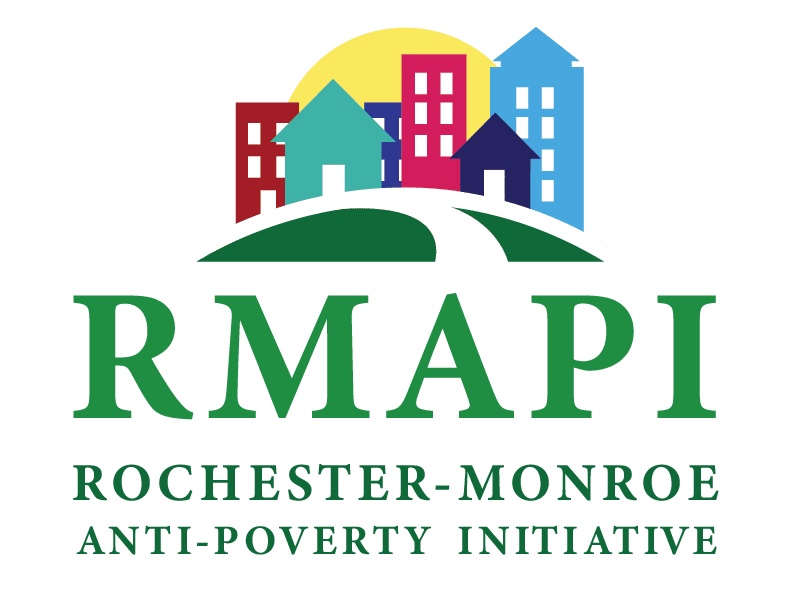ACABANDO CON LA POBREZA
ENTENDIENDO LA POBREZA EN ROCHESTER
The poverty statistics for the City of Rochester are appalling. Almost one-third of the population lives below the poverty line. Of these, half live in extreme poverty— meaning that the household income is half of the federal poverty level. Most shocking is the fact that one out of every two children in Rochester lives in poverty.
NUESTROS OBJETIVOS PARA EL CAMBIO SISTEMICO
El Colectivo RMAPI ha desarrollado un conjunto de resultados y objetivos sistémicos que definen el trabajo de nuestro plan de acción de unidad. Hemos analizado los obstáculos de la movilidad ascendente en nuestras comunidades, hemos recabado información de expertos en contenido y contexto, y hemos invitado a aprender de todo el país. Estas declaraciones reflejan los cambios visionarios de los sistemas que queremos ver, y cómo será cuando se alcancen nuestros objetivos.
NOS IMAGINAMOS UN FUTURO EN EL QUE TODOS...
Nuestras decisiones y acciones se centrarán en aquellos que históricamente se han visto desfavorecidos por el racismo, los traumas y la desinversión comunitaria.
A war on LA POBREZA.
More than 50 years after President Lyndon Johnson declared the War on Poverty, Rochester, New York faces a crisis. Among comparably-sized U.S. cities, Rochester has the highest rate of childhood poverty, the highest rate of extreme poverty, and the second-highest rate of poverty in the nation.
Las estadísticas de pobreza en el condado de Monroe, especialmente en la ciudad de Rochester, son espantosas. Casi un tercio de la población vive por debajo del umbral de la pobreza. De ellos, la mitad vive en la pobreza extrema, lo que significa que los ingresos del hogar son la mitad del nivel de pobreza federal. Pero lo más impactante es el hecho de que uno de cada dos niños de Rochester vive en la pobreza.
A 2013 report by the Rochester Area Community Foundation and ACT Rochester served as a wake-up call to Rochester and Monroe County’s growing poverty and highlighted the concentrated, multi-generational nature of the issue in the city. In the area known as “The Crescent,” more than 60% of residents live in poverty. This extreme concentration of poverty manifests itself in limited local employment, housing blight, food deserts and the isolation of the residents of these neighborhoods.
Los índices de pobreza están disminuyendo en Rochester.
The Rochester-Monroe Anti-Poverty Initiative first brought community members together in 2015, the goal was to address theroot causes of poverty—especially the structural racism that intentionally kept so many of Rochester’s residents trapped in a nearly inescapable cycle of poverty.
The coalition aimed to break down and rebuild systems that perpetuate poverty, and has already helped to turn the tide on poverty in Rochester. A report from IBM in 2015 stated that without significant changes, the poverty rate in Rochester would continue to grow and that by 2028, the number of people in poverty would exceed the total populationof those with jobs. Since that report was first published, the once-rapid rate of growth in poverty in Rochester was firstslowed and then reversed. In the latest report from the U.S. Census, the poverty rate for the most recent five-year period decreasedby nearly 10 percent
El 14% de los habitantes de la región de nueve condados experimentamos los retos, barreras y efectos negativos de la pobreza. Pero esta pobreza no está distribuida uniformemente.
viven en la pobreza, frente al 10% de la población blanca..
Resources on Poverty in Rochester
- SPECIAL REPORT: POVERTY AND THE CONCENTRATION OF POVERTY IN THE NINE-COUNTY GREATER ROCHESTER AREA (ACT ROCHESTER 2013)
- BENCHMARKING ROCHESTER’S POVERTY: A 2015 UPDATE AND DEEPER ANALYSIS OF POVERTY IN THE CITY OF ROCHESTER (ACT ROCHESTER 2015)
- ROCHESTER, USA SMARTER CITIES CHALLENGE REPORT (IBM 2015)
- POVERTY AND SELF-SUFFICIENCY INTHE NINE-COUNTY GREATER ROCHESTER AREA (ACT ROCHESTER 2016)
- PROGRESS REPORT: A ROADMAP FOR CHANGE (RMAPI 2015)
- RMAPI COMMUNITY CONCERNS ASSESSMENT (2020)
